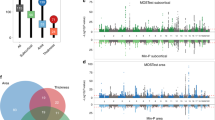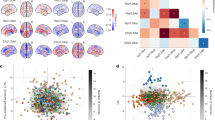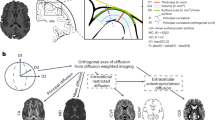Abstract
Human brain anatomy is strikingly diverse and highly inheritable: genetic factors may explain up to 80% of its variability. Prior studies have tried to detect genetic variants with a large effect on neuroanatomical diversity, but those currently identified account for <5% of the variance. Here, based on our analyses of neuroimaging and whole-genome genotyping data from 1765 subjects, we show that up to 54% of this heritability is captured by large numbers of single-nucleotide polymorphisms of small-effect spread throughout the genome, especially within genes and close regulatory regions. The genetic bases of neuroanatomical diversity appear to be relatively independent of those of body size (height), but shared with those of verbal intelligence scores. The study of this genomic architecture should help us better understand brain evolution and disease.
This is a preview of subscription content, access via your institution
Access options
Subscribe to this journal
Receive 12 print issues and online access
$259.00 per year
only $21.58 per issue
Buy this article
- Purchase on Springer Link
- Instant access to full article PDF
Prices may be subject to local taxes which are calculated during checkout


Similar content being viewed by others
References
Winkler AM, Kochunov P, Blangero J, Almasy L, Zilles K, Fox PT et al. Cortical thickness or grey matter volume? The importance of selecting the phenotype for imaging genetics studies. NeuroImage 2010; 53: 1135–1146.
Stein JL, Medland SE, Vasquez AA, Hibar DP, Senstad RE, Winkler AM et al. Identification of common variants associated with human hippocampal and intracranial volumes. Nat Genet 2012; 44: 552–561.
Blokland GAM, de Zubicaray GI, McMahon KL, Wright MJ . Genetic and Environmental Influences on Neuroimaging Phenotypes: A Meta-Analytical Perspective on Twin Imaging Studies. Twin Res Hum Genet 2012; 15: 351–371.
Jahanshad N, Lee AD, Barysheva M, McMahon KL, de Zubicaray GI, Martin NG et al. Genetic influences on brain asymmetry: a DTI study of 374 twins and siblings. NeuroImage 2010; 52: 455–469.
Amaral DG, Schumann CM, Nordahl CW . Neuroanatomy of autism. Trends Neurosci 2008; 31: 137–145.
Steen RG, Mull C, Mcclure R, Hamer RM, Jeffrey A, Steen ANT et al. Brain volume in first-episode schizophrenia: Systematic review and meta-analysis of magnetic resonance imaging studies. Br J Psychiatry 2012, 188: 510–518.
Bis JC, DeCarli C, Smith AV, van der Lijn F, Crivello F, Fornage M et al. Common variants at 12q14 and 12q24 are associated with hippocampal volume. Nat Genet 2012; 44: 545–551.
Ikram MA, Fornage M, Smith AV, Seshadri S, Schmidt R, Debette S et al. Common variants at 6q22 and 17q21 are associated with intracranial volume. Nat Genet 2012; 44: 539–544.
Yang J, Benyamin B, McEvoy BP, Gordon S, Henders AK, Nyholt DR et al. Common SNPs explain a large proportion of the heritability for human height. Nat Genet 2010; 42: 565–569.
Yang J, Manolio T a, Pasquale LR, Boerwinkle E, Caporaso N, Cunningham JM et al. Genome partitioning of genetic variation for complex traits using common SNPs. Nat Genet 2011; 43: 519–525.
Schumann G, Loth E, Banaschewski T, Barbot A, Barker G, Büchel C et al. The IMAGEN study: reinforcement-related behaviour in normal brain function and psychopathology. Mol Psychiatry 2010; 15: 1128–1139.
Jenkinson M, Bannister P, Brady M, Smith S . Improved optimization for the robust and accurate linear registration and motion correction of brain images. NeuroImage 2002; 17: 825–841.
Smith SM, Jenkinson M, Woolrich MW, Beckmann CF, Behrens TEJ, Johansen-Berg H et al. Advances in functional and structural MR image analysis and implementation as FSL. NeuroImage 2004; 23 (Suppl 1): S208–S219.
Buckner RL, Head D, Parker J, Fotenos AF, Marcus D, Morris JC et al. A unified approach for morphometric and functional data analysis in young, old, and demented adults using automated atlas-based head size normalization: reliability and validation against manual measurement of total intracranial volume. NeuroImage 2004; 23: 724–738.
Cox RW . AFNI: software for analysis and visualization of functional magnetic resonance neuroimages. Comput Biomed Res 1996; 29: 162–173.
Zhang Y, Brady M, Smith S . Segmentation of brain MR images through a hidden Markov random field model and the expectation-maximization algorithm. IEEE Trans Med Imaging 2001; 20: 45–57.
Patenaude B, Smith SM, Kennedy DN, Jenkinson M . A Bayesian model of shape and appearance for subcortical brain segmentation. NeuroImage 2011; 56: 907–922.
Purcell S, Neale B, Todd-Brown K, Thomas L, Ferreira MAR, Bender D et al. PLINK: a tool set for whole-genome association and population-based linkage analyses. Am J Hum Genet 2007; 81: 559–575.
Lee SH, Yang J, Goddard ME, Visscher PM, Wray NR . Estimation of pleiotropy between complex diseases using single-nucleotide polymorphism-derived genomic relationships and restricted maximum likelihood. Bioinforma Oxf Engl 2012; 28: 2540–2542.
Carskadon MA, Acebo C . A self-administered rating scale for pubertal development. J Adolesc Health Off Publ Soc Adolesc Med 1993; 14: 190–195.
Alexander DH, Novembre J, Lange K . Fast model-based estimation of ancestry in unrelated individuals. Genome Res 2009; 19: 1655–1664.
International HapMap Consortium. The International HapMap Project. Nature 2003; 426: 789–796.
Price AL, Patterson NJ, Plenge RM, Weinblatt ME, Shadick NA, Reich D . Principal components analysis corrects for stratification in genome-wide association studies. Nat Genet 2006; 38: 904–909.
Tian C, Plenge RM, Ransom M, Lee A, Villoslada P, Selmi C et al. Analysis and application of European genetic substructure using 300K SNP information. PLoS Genet 2008; 4: e4–e4.
Visscher PM, Hemani G, Vinkhuyzen AAE, Chen G-B, Lee SH, Wray NR et al. Statistical Power to Detect Genetic (Co)Variance of Complex Traits Using SNP Data in Unrelated Samples. PLoS Genet 2014; 10: e1004269.
Davies G, Tenesa A, Payton A, Yang J, Harris SE, Liewald D et al. Genome-wide association studies establish that human intelligence is highly heritable and polygenic. Mol Psychiatry 2011; 16: 996–1005.
Raychaudhuri S, Korn J, McCarroll S. International Schizophrenia Consortium, Altshuler D, Sklar P . Accurately assessing the risk of schizophrenia conferred by rare copy-number variation affecting genes with brain function. PLoS Genet 2010; 6: e1001097.
Lee SH, DeCandia TR, Ripke S, Yang J, Sullivan PF, Goddard ME et al. Estimating the proportion of variation in susceptibility to schizophrenia captured by common SNPs. Nat Genet 2012; 44: 247–250.
Kremen WS, Prom-Wormley E, Panizzon MS, Eyler LT, Fischl B, Neale MC et al. Genetic and environmental influences on the size of specific brain regions in midlife: the VETSA MRI study. NeuroImage 2010; 49: 1213–1223.
Yoon U, Perusse D, Lee J-M, Evans AC . Genetic and environmental influences on structural variability of the brain in pediatric twin: deformation based morphometry. Neurosci Lett 2011; 493: 8–13.
Den Braber A, Bohlken MM, Brouwer RM, van ’t Ent D, Kanai R, Kahn RS et al. Heritability of subcortical brain measures: a perspective for future genome-wide association studies. NeuroImage 2013; 83: 98–102.
Purcell SM, Moran JL, Fromer M, Ruderfer D, Solovieff N, Roussos P et al. A polygenic burden of rare disruptive mutations in schizophrenia. Nature 2014; 506: 185–190.
Robinson MR, Wray NR, Visscher PM . Explaining additional genetic variation in complex traits. Trends Genet 2014; 30: 124–132.
Trzaskowski M, Dale PS, Plomin R . No genetic influence for childhood behavior problems from DNA analysis. J Am Acad Child Adolesc Psychiatry 2013; 52 1048–1056. e3.
Cook EH Jr, Scherer SW . Copy-number variations associated with neuropsychiatric conditions. Nature 2008; 455: 919–923.
Cross-Disorder Group of the Psychiatric Genomics Consortium. Genetic relationship between five psychiatric disorders estimated from genome-wide SNPs. Nat Genet 2013; 45: 984–994.
Lee SH, Harold D, Nyholt DR, Goddard ME, Zondervan KT, Williams J et al. Estimation and partitioning of polygenic variation captured by common SNPs for Alzheimer’s disease, multiple sclerosis and endometriosis. Hum Mol Genet 2013; 22: 832–841.
Klei L, Sanders SJ, Murtha MT, Hus V, Lowe JK, Willsey AJ et al. Common genetic variants, acting additively, are a major source of risk for autism. Mol Autism 2012; 3: 9.
Park J-H, Wacholder S, Gail MH, Peters U, Jacobs KB, Chanock SJ et al. Estimation of effect size distribution from genome-wide association studies and implications for future discoveries. Nat Genet 2010; 42: 570–575.
Meyer-Lindenberg A, Weinberger DR . Intermediate phenotypes and genetic mechanisms of psychiatric disorders. Nat Rev Neurosci 2006; 7: 818–827.
Acknowledgements
This work was supported by the European Union-funded FP6 Integrated Project IMAGEN (Reinforcement-related behaviour in normal brain function and psychopathology; LSHM-CT-2007-037286), the FP7 projects ADAMS (Genomic variations underlying common neuropsychiatric diseases and diseases related to cognitive traits in different human populations; 242257), the Innovative Medicine Initiative Project EU-AIMS (115300-2), the Medical Research Council Programme Grant ‘Developmental pathways into adolescent substance abuse’ (93558), the Swedish Funding Agency FORMAS, the German Bundesministerium und Forschung (FKZ: 01EV0711), Institut Pasteur, CNRS, Université Paris Diderot, the Bettencourt-Schueller Foundation, the Conny-Maeva Foundation, the Orange Foundation, the FondaMental Foundation and the Cognacq-Jay Foundation.
Author information
Authors and Affiliations
Corresponding author
Ethics declarations
Competing interests
The authors declare no conflict of interest.
Additional information
Supplementary Information accompanies the paper on the Molecular Psychiatry website
PowerPoint slides
Rights and permissions
About this article
Cite this article
Toro, R., Poline, JB., Huguet, G. et al. Genomic architecture of human neuroanatomical diversity. Mol Psychiatry 20, 1011–1016 (2015). https://doi.org/10.1038/mp.2014.99
Received:
Revised:
Accepted:
Published:
Issue Date:
DOI: https://doi.org/10.1038/mp.2014.99
This article is cited by
-
Identifying genes associated with brain volumetric differences through tissue specific transcriptomic inference from GWAS summary data
BMC Bioinformatics (2022)
-
A cognitive neurogenetic approach to uncovering the structure of executive functions
Nature Communications (2022)
-
Jenseits von IMAGEN: populationsneurowissenschaftliche Strategien für klinische und globale Kohorten in den STRATIFY- und GIGA-Konsortien
Der Nervenarzt (2021)
-
Human Connectome Project: heritability of brain volumes in young healthy adults
Experimental Brain Research (2021)
-
Identifying biological markers for improved precision medicine in psychiatry
Molecular Psychiatry (2020)



